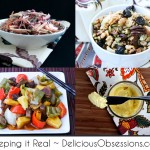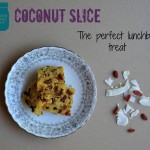Let’s talk about bacteria, baby.
I am just going to tell you all about MY bacteria, for starters (ahaha, you see what I did there? bacteria? starters?). (Okay, putting on my serious face now…)
Now, I will be the first to admit that none of what I am about to say about my gut has actually been scientifically confirmed. I’m just basing it off the fact that I’m reacting to… oh, you know, just about everything at the moment. All grains, all beans, all pulses… Yep, that’s me! I haven’t had an allergy test or the likes yet. Why? Because it’s ridiculously expensive! Last time I enquired, I was looking at around $250. Each. But I am actually going to have to go and get something figured out, just because the amount of things I am reacting to is ridiculous.;
It’s very clearly digestive. Let’s just leave it at that, I don’t think you all need a blow-by-blow account of my symptoms. So while I drag my feet organising some kind of formal investigation, I am focussing on reduced grains, properly preparing any grains I do consumer (soaking and sprouting), properly prepardin nuts and seeds too, as well as doing various ferments to increase the good bacteria in my gut.
Anyone grossed out by the words bacteria and fermented? You shouldn’t be.
Us humans NEED bacteria. Good bacteria. Our guts can’t work without it. Basically, the entire wall of our digestive tract should be teeming with good bacteria (or, as my son likes to call them, ‘the good guys’) to aid in digestion. Unfortunately, due to pasteurisation, sterilisation, antibiotics, overuse of soap/hand sanitiser/disinfectant/chemicals-in-general and the modern diet, our guts are suffering. We have a much higher population of the less-than-desirable bacteria in our gut than we should. Which therefore means we have less of the good guys in there because the bad guys are taking up all the space! I think we all need to be aware of this, and do what we can to boost the chances of the good guys. But even more so if you have intolerances or allergies, or some undiagnosed weirdness (such as myself).
But have any of you tried to get the good guys into kids?!? It’s just not easy. I have a very un-picky eater, and even I struggle. My boy loved fermented vegetables at first, but will suddenly not go near them. He won’t drink kombucha. Or rejuvelac. He’ll eat yoghurt, but that’s about where it ends.
He does like tomato sauce, though. And by tomato sauce, I really mean tomato paste… I’ve only ever served him up tomato paste (and even that doesn’t happen very often), and I just call it tomato sauce. But I get that most kids like a bit of real tomato sauce – ketchup. I bet the kids can’t tell that this tomato sauce is fermented. It’s deeeelicious, and packed full of the good bacteria that we all need!
Fermented Tomato Sauce
Ingredients:
400g tomato paste*
80g raw honey
60g whey**, plus extra to cover
35g apple cider vinegar (raw, unfiltered)
2-3 pinches fine sea salt
1 tsp allspice
1/8-1/4 tsp ground cloves (for kids, I would stick with 1/8 tsp)
1/4 tsp cinnamon (optional)
Method:
1) Put all ingredients in TM bowl and mix for 15 seconds on speed 3.
2) Scrape down the sides and repeat.
3) Put the tomato sauce in a jar, cover with a thin film of the extra whey, seal the jar, and leave it on the benchtop to ferment for 3-4 days (2-3 days in summer).
4) Stir it and pop it in the fridge!
It makes 500ml and you should store it in the fridge after fermenting. It should last a couple of months, but make sure you are using a clean spoon each time you take some out and that no food crumbs get in there by mistake!
*ideally homemade, but we’re not in tomato season at the moment… organic paste in a glass jar is your best bet – I buy Global Organics in winter
**what is whey?!? it’s just the liquid strained off yoghurt – get ‘normal’ yoghurt and strain it to get whey + greek yoghurt, or get greek yoghurt and strain it to get whey + yoghurt cheese… make sure you get live, pot set yoghurt – or better yet, make your own!!
What do you ferment? 🙂







I’ve been looking forward to this since you first mentioned it a couple of months ago…it’s on the menu for this week 🙂
Oooh, love that you’ve been paying attention, Kirsty! How did you go with the fermented tomato sauce? We loooove it! 🙂 xoxo
Wonder why you don’t use kiefer whey?
Hi Martha! You could absolutely use kefir whey! Our kefir usually gets all used up in a smoothie each morning – we never seem to be able to keep enough of it to use the whey for fermenting. I make raw milk yoghurt, which never sets quite as firm as ‘regular’ yoghurt, so I always strain it which leaves me with some whey and that’s what I have used in the past. However, I now most often use the whey leftover from clabbering milk (I make cream cheese more often than I make yoghurt these days). Any of those three sources of whey would be fine. Hope that helps! Sarah xoxo
Can I use something other than whey? I don’t have any at present- will it still work with acv? (not sure how to source whey either)
Hi Kerri. You can use a little bit of juice from any vegetable ferments – sauerkraut juice, brine from lactofermented pickles/carrots/etc. You can use the whey that is released from yoghurt, or from clabbered milk (raw milk that has been left to culture naturally and then strained).
Hope that helps!! 🙂
Would regular honey (ie that isn’t raw) work just as well…I recognize it wouldn’t have the same health benefits.
Absolutely! 🙂